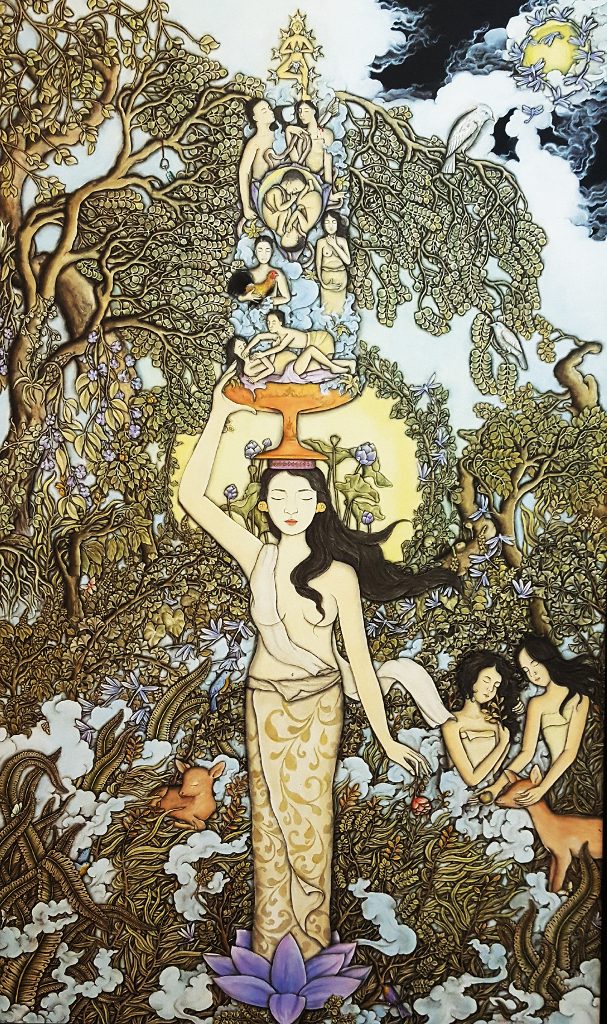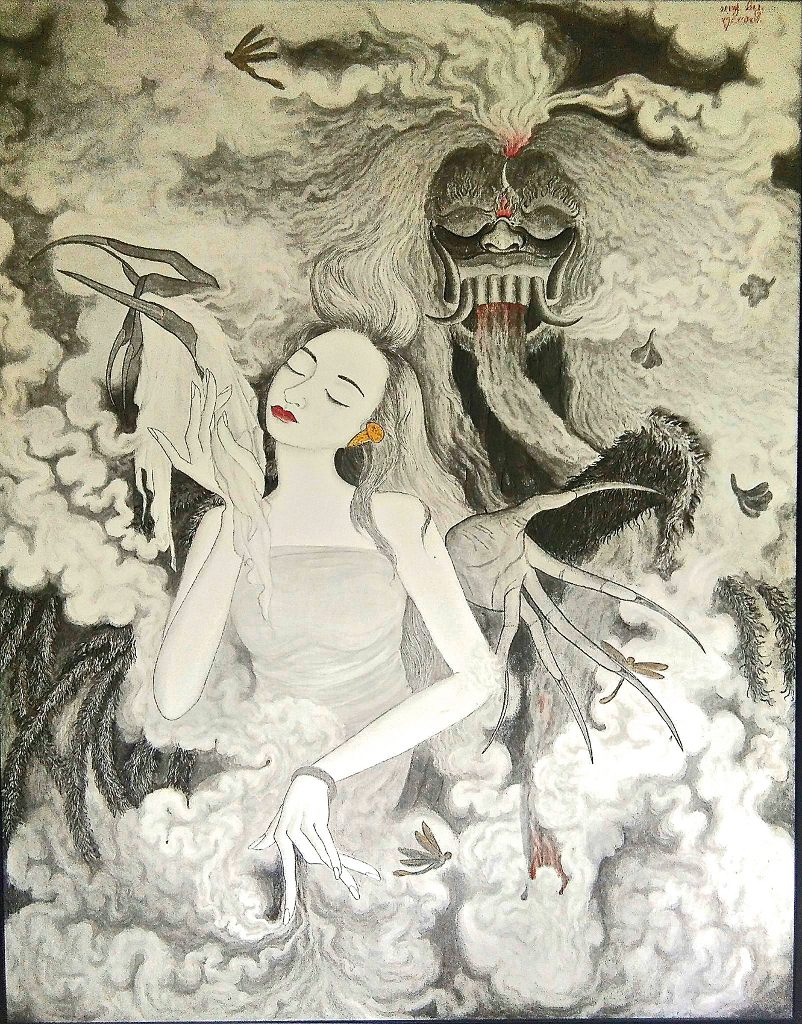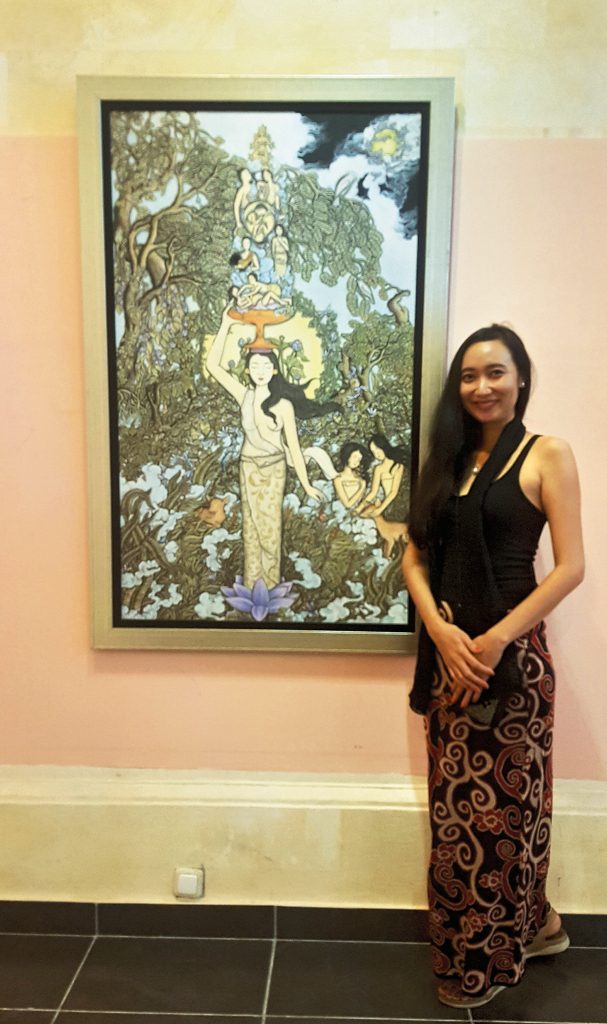A beautiful, naked woman with long flowing hair sits legs raised, feet positioned above her head. In her left hand she is holding a red lotus flower covering her groin. “Fragrance” an intimate, yet daring sketch by Balinese artist Satya Cipta ‘speaks’ of the feminine physical, and worldly splendour, and according to the artist, a woman’s desire to be perceived as one of nature’s most beautiful gifts.

“Broken Vulva”, on the other hand, is in stark contrast. It illustrates a woman ripping open her vagina, while a symbol of red fire is sited between her legs. This is a depiction of violence.
Explicit images of the body are in no way considered by the Balinese as vulgar or pornographic, they are essential teachings about the mysteries of human life and its origins. While male sexuality is openly explored in Balinese art, few artists are willing to expose female sexuality – the violence and suffering – as Satya has done.
In “A Budding Talent”, which closed 16 November 2018 at Ubud’s Puri Lukisan, emerging artist Satya Cipta, in her first solo exhibition reveals the pleasure and pain, and the horror and beauty that are constant realities for the women of the Balinese culture.
In her semiotic works she juxtaposes themes such as resentment, marriage without love, adultery and rape with fertility, intimacy, solitude and passionate love. And while it is the complexity of her compositions, enhanced by the distinct power of her lines that reveal the aesthetic beauty of her works, like a poison pen the line is contrasted with wildly imaginative narratives. Some are not for the faint-hearted – they convey what is considered taboo within Balinese art.

An outsider within her own culture, Satya’s situation is unlike many Balinese. Born in Lombok she came to Bali at a young age, then later moved to South Sumatra and resided with her family in a small minority Balinese group within an Islamic and Christian dominated environment. She went on to study theatre and performance in Jakarta before returning to Bali. Living outside of Bali, as well as in the nation’s capital, gifted her an open and modern worldview.
“Before, when I was living in Sumatra and Jakarta I was proud to be Balinese and loved to participate in the ceremonies and rituals. When I returned to Bali I found things were much different,” Satya said. “I witnessed how people engaged in their religion within the temples showing respect to the gods and goddesses. When they returned home, however, they could not respect the real women in their lives – their mothers, sisters and wives.” She continued, “I discovered the domestic violence, and that women are trapped within their roles and cannot live their lives how they wish.”
Destined to create controversy in this fiercely patriarchal society, Satya is willing to courageously speak her mind. “I paint my pain,” she stated. “Yet this represents not only myself, but many other women throughout the world. I want people to understand about the position of the woman’s life within the Balinese society. Maybe it is forbidden – but I have to say it.”
“Change is slowly happening,” she admits. “The most difficult thing is to introduce the change. The first women to do so endure much criticism, then the others can more easily follow on.” Through Satya’s work we may witness a new era and that Balinese women, too, are prepared to stand up in protest.
Her criticisms, however, are not only directed at men. In “Emptiness”, 2018 Satya depicts the scenario of a woman who marries into a family yet disrespects her mother-in-law. “Many women also forget their parents at home and wait for them to die so they can inherit the family’s land. She looks so beautiful, yet she is empty.”

A self-taught artist from the age of fourteen a decade later Satya began learning the renowned Batuan painting traditions. From there she kept pushing forward, eager to improve and not to become stuck within the traditional mind-set. Two years ago she began studying under Ketut Budiana, recognised as one of the greatest living Balinese artists. “I am stepping into the next phase of my creative journey, and there is much to learn,” Satya said.
Holding her first solo exhibition at Puri Lukisan Museum, Ubud’s oldest and most important art museum, grants the artist immediate endorsement from the highest levels of the Balinese art establishment. Satya, however, remains humble. Offers have come from a leading regional gallery, but Satya chooses to reject them, remembering that its her process that is essential and only when she believes she is ready will she focus on the international stage.
A wonderful and abundant source of creativity, she is also a gifted actor, performer and singer. We eagerly await Satya Cipta’s next artistic offerings.






